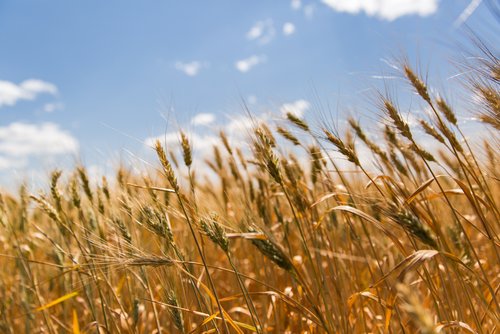Improving Profitability of Hard Red Spring Wheat for Eastern Canada Through Superior Grain Yields, Fusarium Head Blight Resistance, and Improved End-Use Quality

Written by: Michelle Boulton
Although his program is small, Andrew Burt, Agriculture and Agri-Food Canada (AAFC), Ottawa Research and Development Centre, has big ambitions. His research is focused on improving the profitability of hard red spring wheat for eastern Canada through better grain yields, Fusarium head blight (FHB) resistance, and end-use quality.
“Almost 90 percent of wheat production is in western Canada. And of the remaining 10 percent in eastern Canada, a lot is winter wheat. So, in terms of scale, we’re small,” he concedes, “but we’re covering a lot of territory—eastern Canada is a huge and varied landscape.”
He says one of the big strengths of his program is that it’s part of the AAFC network. “One of the important roles of public breeding is serving markets that would otherwise be ignored. This program does that by focusing on the specific needs of growers in eastern Canada.”
Through AAFC’s spring wheat breeding networks, Burt accesses western germplasm and has been incorporating Canada western red spring (CWRS) wheat cultivars and breeding lines from the Swift Current and Brandon programs into most of his crosses in the last five years. He tests them in two key breeding sites—the Ottawa Research Centre and the Charlottetown Research Centre—where the two sister arms of his program are run.
“Historically, eastern wheat has been higher yielding than western wheat. Breeders in eastern Canada have been more focused on Fusarium and powdery mildew resistance, and less focused on end-use quality,” says Burt. “Investment in western Canadian breeding has probably put an end to the yield differential between eastern and western hard red spring varieties, but we still have lower end-use quality.”
Burt sees that disparity as an opportunity for growth in the Canadian eastern red spring (CERS) class. “Something like 60% of what is milled in eastern Canada is CWRS wheat. If we can achieve quality that rivals CWRS wheat, perhaps we can capture interest in locally produced wheat and shorter supply chains to improve that percentage.”
Burt’s breeding efforts have been “trying to introduce higher grain quality, higher protein content, and better milling quality. That’s not an easy recipe to achieve—anytime you’re trying to make a fairly large change in protein quality or protein content, you’re doing well if you’re maintaining yield,” he says.
A persistent threat to grain quality is FHB. “The Fusarium challenge isn’t going away,” asserts Burt. “With increasing variability in the climate and increasing heat, it’s going to be a challenge to improve on the level of resistance we have in eastern Canada.”
Burt has been in his current position since 2018 and, while he has not yet successfully put forward a new variety for commercialization, two lines from his program were just supported for registration at the February 2023 Quebec Recommending Committee for Cereal meeting—ECSW237 is a feed wheat and ECSW244 is a milling wheat (suitable for the CERS market class). In 2019, a semi-dwarf line with moderate resistance to FHB was accepted for registration in Ontario, but he says the protein quantity was just too low to be supported in the CERS class, and it hasn’t been picked up for commercialization. He’s feeling more confident about some of the lines still coming in his pipeline.
“It’s a little disappointing to get to the end of five years and say, ‘it has been a rebuilding time,’ but that’s the reality,” he explains. “It takes a long time to steer these programs, and I think we’re in a good position for the next 5 to 10 years. We have a lot of material in the pipeline that combines higher protein with good end-use quality and, in some cases, high yield.”
This Wheat Cluster project received funding from the Canadian Field Crop Research Alliance.